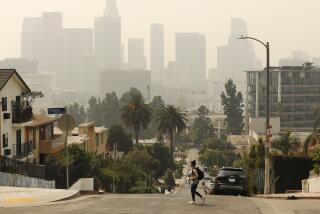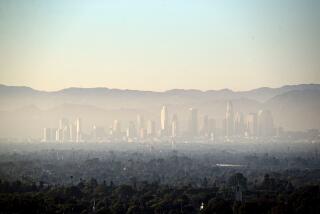Ozone Loss Figures Sharply Raised; 200,000 More Deaths Likely
- Share via
WASHINGTON — The protective ozone in the Earth’s upper atmosphere is being depleted much faster than scientists realized and the United States could suffer 200,000 more skin cancer deaths than previously expected over the next 50 years, the nation’s top environmental official said Thursday.
Rather than thinning by 1% to 3% during the previous 12 years, as earlier studies indicated, the ozone layer over the United States apparently has been degraded 4% to 5%, according to William K. Reilly, administrator of the Environmental Protection Agency. Reilly said that the new evidence suggesting greater depletion was gathered by the National Aeronautics and Space Administration.
In light of the new studies, Reilly is intensifying an EPA campaign to reduce the use of ozone-damaging chemicals and “exploring the full range of options” to help developing countries do the same, he told an audience in St. Paul, Minn.
According to the National Cancer Institute, U.S. skin cancer mortality is now about 8,500 a year. Eileen Claussen, director of the EPA’s Office of Atmospheric and Indoor Air Programs, called the projections of an additional 200,000 deaths over the next half century “shocking.”
The disclosure was made just nine months after 53 signatories to an international treaty committed themselves to banning, by the year 2000, the chemicals that are the chief threat to the ozone layer.
Although ozone is one of the principal components of smog, its presence in the stratosphere protects life on Earth from the sun’s destructive ultraviolet radiation.
Destruction of the atmospheric ozone is caused by a number of chlorine-containing chemicals--halons, which are used in fire extinguishers, and chlorofluorocarbons or CFCs, including refrigerants such as Freon.
Some environmentalists and EPA officials called the new evidence shocking. But UC Irvine Prof. Sherwood Rowland, one of the scientists who first linked CFCs and depletion of the ozone, said he is not especially surprised, because chlorine levels in the atmosphere continue to increase.
When they reach the upper atmosphere, CFCs and halons are broken down by ultraviolet radiation and release chlorine, which in turn destroys ozone.
The phenomenon has been most pronounced during the dark winters in Antarctica, where a huge hole forms in the ozone layer each year. But evidence has steadily mounted that the assault on ozone also goes on over the northern latitudes.
Two years after the first binding agreement to address the problem, the international treaty was dramatically strengthened last year in London. Besides agreeing to ban CFCs and most halons by the year 2000, industrial nations agreed to phase out the use of the chlorine-containing solvents methyl chloroform and carbon tetrachloride.
The new NASA satellite data, compiled by Richard Stolarski at the agency’s Goddard Space Flight Center in Greenbelt, Md., first was reported at a meeting of the American Geophysical Union last year, but the EPA analysis was only recently completed.
Claussen of the EPA suggested possible ways to strengthen efforts to hasten the demise of ozone-damaging chemicals.
Under last year’s London agreement, developing countries were given an additional 10 years to stop the use of CFCs. Under the circumstances, Claussen said, they might be put on the same schedule with industrial countries--to ban the chemicals by the year 2000.
She suggested also the possibility of tightening controls and speeding the phase-out of so-called HCFCs--chemicals being produced as CFC substitutes. Although less damaging than CFCs, they contain chlorine and degrade the ozone. Under the present agreement, they are to be phased out in the year 2030.
“The current plan to eliminate these chemicals by the year 2000 is dangerously slow,” said Liz Cook of the environmental group Friends of the Earth, “and these data should send a strong message to chemical companies not to develop substitutes that deplete the ozone, even if they are somewhat less harmful than CFCs.”
More to Read
Sign up for Essential California
The most important California stories and recommendations in your inbox every morning.
You may occasionally receive promotional content from the Los Angeles Times.










